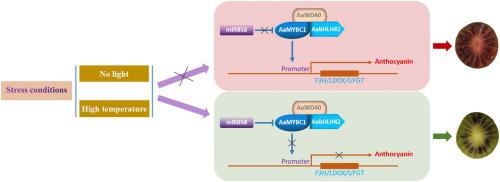当前位置:
X-MOL 学术
›
Plant Sci.
›
论文详情
Our official English website, www.x-mol.net, welcomes your
feedback! (Note: you will need to create a separate account there.)
MicroRNA858 negatively regulates anthocyanin biosynthesis by repressing AaMYBC1 expression in kiwifruit (Actinidia arguta)
Plant Science ( IF 4.2 ) Pub Date : 2020-07-01 , DOI: 10.1016/j.plantsci.2020.110476 Yukuo Li 1 , Wen Cui 2 , Xiujuan Qi 2 , Miaomiao Lin 2 , Chengkui Qiao 2 , Yunpeng Zhong 2 , Chungen Hu 3 , Jinbao Fang 2
Plant Science ( IF 4.2 ) Pub Date : 2020-07-01 , DOI: 10.1016/j.plantsci.2020.110476 Yukuo Li 1 , Wen Cui 2 , Xiujuan Qi 2 , Miaomiao Lin 2 , Chengkui Qiao 2 , Yunpeng Zhong 2 , Chungen Hu 3 , Jinbao Fang 2
Affiliation

|
The anthocyanin biosynthetic pathway regulated by exogenous and endogenous factors through sophisticated networks has been extensively studied in kiwifruit (Actinidia arguta). However, the role of micro RNAs (miRNAs) as regulatory factor in this process is largely unclear. Here, we demonstrate that miR858 is a negative regulator of anthocyanin biosynthesis by repressing the target gene AaMYBC1 in red-colored kiwifruit. Transient co-transformation in Nicotiana benthamiana confirmed that miR858 could target AaMYBC1, which was identified to be an R2R3-type tanscription factor (TF). Subcellular localization showed that AaMYBC1 was located in the nucleus, indicating AaMYBC1 protein could act as a transcriptional regulator in plant cells. Functional protein association network analysis and the yeast two hybrid (Y2H) assay revealed that AaMYBC1 and AabHLH42 interact with each other. Silencing of AaMYBC1 using the virus-induced gene silencing method in the core of A. arguta 'HB' ('Hongbaoshixing', a kind of red-fleshed A. arguta cultivar) fruits reduced the accumulation of anthocyanin and decreased the expression of late biosynthetic genes. miR858 overexpression played a stronger role than AaMYBC1 silencing in the inhibition of coloration. With overexpression of miR858, A. arguta did not present coloration, and anthocyanin was hardly detected. Together, these results clarify the negative regulatory role of miR858 in mediating anthocyanin biosynthesis and accumulation in A. arguta, providing novel insights into the molecular mechanism of anthocyanin biosynthesis.
中文翻译:

MicroRNA858 通过抑制猕猴桃 (Actinidia arguta) 中 AaMYBC1 的表达负调控花青素生物合成
在奇异果(Actinidia arguta)中,外源性和内源性因素通过复杂网络调控的花青素生物合成途径已得到广泛研究。然而,微小 RNA (miRNA) 在该过程中作为调节因子的作用在很大程度上尚不清楚。在这里,我们通过抑制红色猕猴桃中的靶基因 AaMYBC1 来证明 miR858 是花青素生物合成的负调节因子。本氏烟草中的瞬时共转化证实 miR858 可以靶向 AaMYBC1,AaMYBC1 被鉴定为 R2R3 型转录因子 (TF)。亚细胞定位显示AaMYBC1位于细胞核内,表明AaMYBC1蛋白可以作为植物细胞的转录调节因子。功能蛋白关联网络分析和酵母二杂种 (Y2H) 分析显示 AaMYBC1 和 AabHLH42 相互作用。使用病毒诱导的基因沉默方法在 A. arguta 'HB'('Hongbaoshixing',一种红肉 A. arguta 栽培品种)果实中沉默 AaMYBC1 减少了花青素的积累并降低了晚期生物合成的表达基因。miR858 过表达比 AaMYBC1 沉默在抑制着色方面发挥了更强的作用。随着miR858的过表达,A. arguta不呈现着色,几乎检测不到花青素。总之,这些结果阐明了 miR858 在介导 A. arguta 中花青素生物合成和积累中的负调控作用,为花青素生物合成的分子机制提供了新的见解。
更新日期:2020-07-01
中文翻译:

MicroRNA858 通过抑制猕猴桃 (Actinidia arguta) 中 AaMYBC1 的表达负调控花青素生物合成
在奇异果(Actinidia arguta)中,外源性和内源性因素通过复杂网络调控的花青素生物合成途径已得到广泛研究。然而,微小 RNA (miRNA) 在该过程中作为调节因子的作用在很大程度上尚不清楚。在这里,我们通过抑制红色猕猴桃中的靶基因 AaMYBC1 来证明 miR858 是花青素生物合成的负调节因子。本氏烟草中的瞬时共转化证实 miR858 可以靶向 AaMYBC1,AaMYBC1 被鉴定为 R2R3 型转录因子 (TF)。亚细胞定位显示AaMYBC1位于细胞核内,表明AaMYBC1蛋白可以作为植物细胞的转录调节因子。功能蛋白关联网络分析和酵母二杂种 (Y2H) 分析显示 AaMYBC1 和 AabHLH42 相互作用。使用病毒诱导的基因沉默方法在 A. arguta 'HB'('Hongbaoshixing',一种红肉 A. arguta 栽培品种)果实中沉默 AaMYBC1 减少了花青素的积累并降低了晚期生物合成的表达基因。miR858 过表达比 AaMYBC1 沉默在抑制着色方面发挥了更强的作用。随着miR858的过表达,A. arguta不呈现着色,几乎检测不到花青素。总之,这些结果阐明了 miR858 在介导 A. arguta 中花青素生物合成和积累中的负调控作用,为花青素生物合成的分子机制提供了新的见解。











































 京公网安备 11010802027423号
京公网安备 11010802027423号